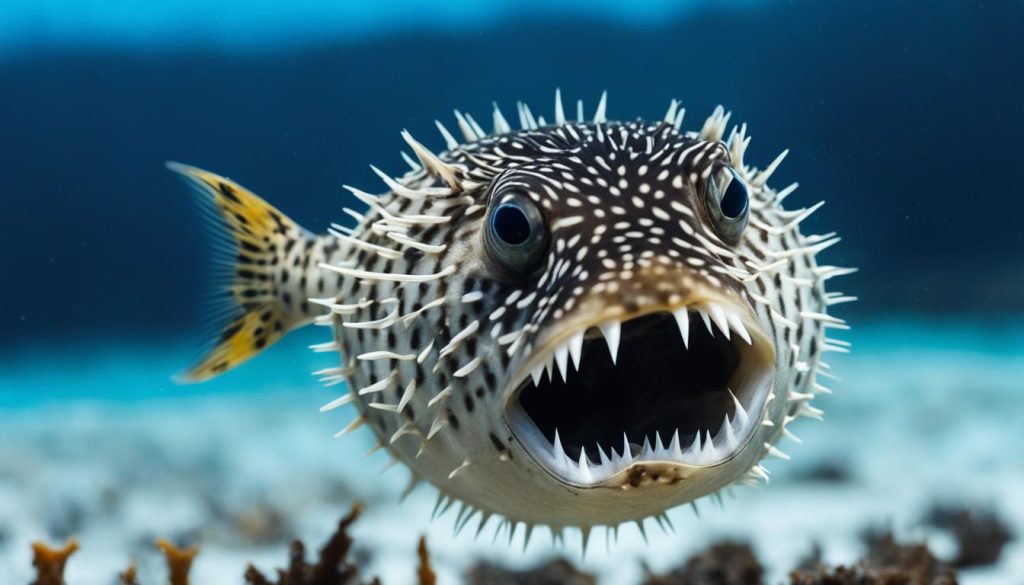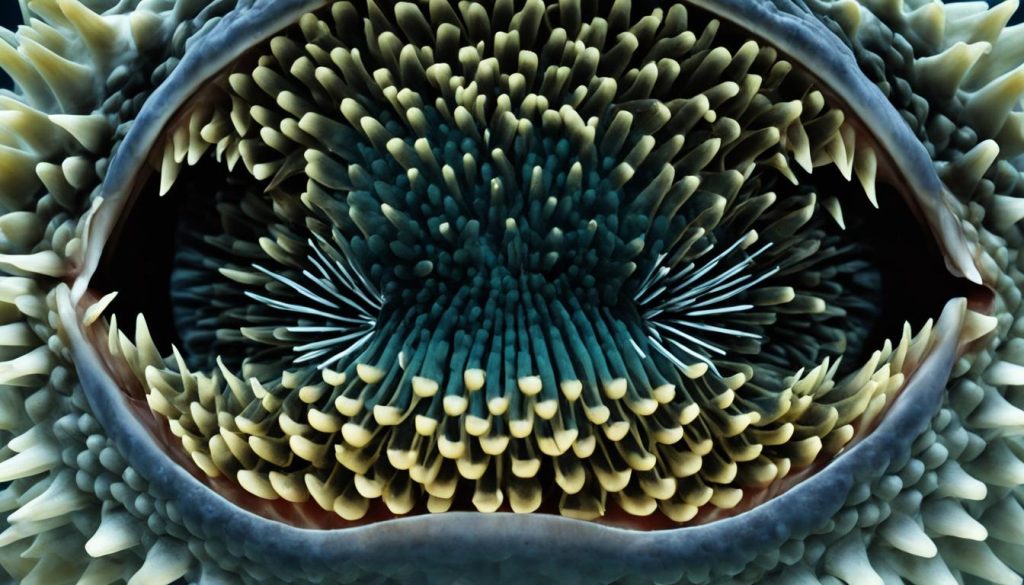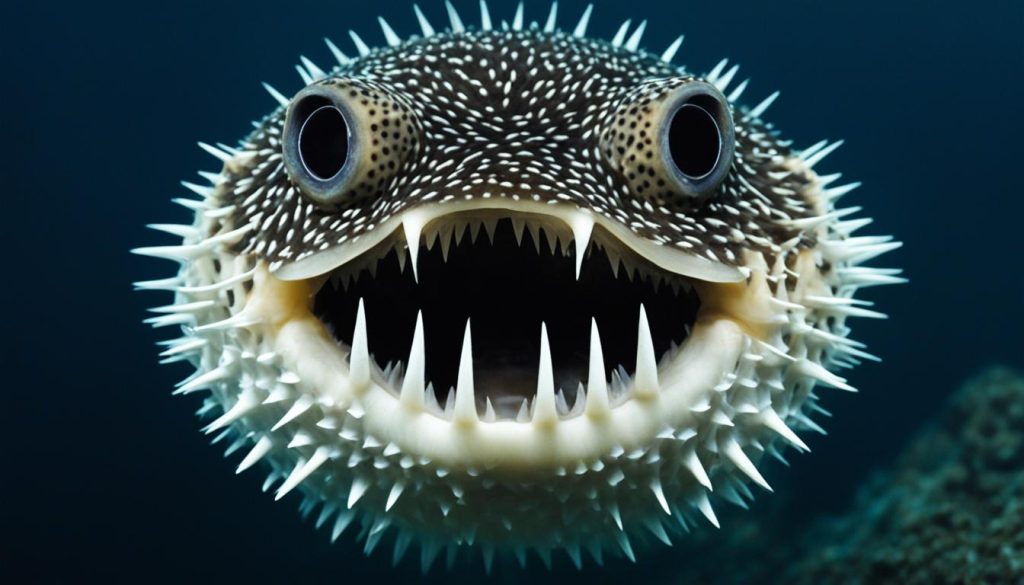Puffer fish are fascinating creatures with unique adaptations that allow them to thrive in their natural habitats. One of the most intriguing aspects of puffer fish is their teeth. Unlike humans and many other animals whose teeth stop growing after a certain point, puffer fish have teeth that continuously grow throughout their lives. This continuous growth is an important adaptation that enables them to survive and thrive in their environments.
The dentition of puffer fish is unlike that of any other fish. Their teeth, also known as beaks, are comprised of fused structures that resemble a beak-like formation. These teeth are not only constantly growing, but they are also continuously being eroded due to the puffer fish’s diet.
The diet of puffer fish consists of snails, shellfish, crustaceans, and other small marine creatures. In order to feed on these prey, puffer fish use their specialized teeth to crush snails and crack open the shells of crabs. The continuous growth of their teeth ensures that they always have sharp and functional dental structures to consume their preferred food sources.
However, this continuous growth also means that puffer fish teeth require proper care and maintenance. Without the proper wear, their teeth can become overgrown and hinder their ability to feed properly. In captivity, puffer fish may require dental work to trim their teeth if they are not wearing them down naturally. It is important that this dental work is performed by a qualified individual while the fish is under sedation to ensure their safety and well-being.
Understanding the unique dentition of puffer fish is crucial for their proper care and overall health. By providing them with the right diet and dental care, we can ensure that these remarkable creatures continue to thrive in both their natural habitats and in captivity.
Puffer Fish Species and Adaptations
Puffer fish are a diverse group of species with over 120 known varieties, the majority of which inhabit marine waters. These fascinating creatures have evolved unique adaptations that enable them to defend themselves against predators and thrive in their environments.
Adaptations for Defense
Puffer fish possess a range of defenses that allow them to avoid becoming a meal for larger creatures. One notable adaptation is their exceptional eyesight, which helps them detect potential threats and predators from a distance.
When faced with danger, puffer fish have the ability to rapidly swim away, utilizing a burst of energy to escape predation. Additionally, puffer fish can inflate their bodies by swallowing water or air, making themselves appear larger and unappetizing to would-be attackers.
Furthermore, puffer fish are equipped with spines and quills covering their bodies, serving as a deterrent against predators. These sharp structures make it difficult for predators to swallow them or even hold onto them, increasing their chances of survival.
Tetrodotoxin: A Deadly Toxin
Another defense mechanism possessed by certain puffer fish species is the ability to produce a potent neurotoxin called tetrodotoxin. This toxin, present in various parts of their bodies, including their skin, liver, and ovaries, can be deadly to predators and even humans if ingested.
The production of tetrodotoxin is a remarkable evolutionary adaptation that provides an additional layer of defense for the puffer fish. The toxin acts as a powerful deterrent, warning potential predators to steer clear of these toxic fish.
Puffer Fish Dentition and Dental Care
Puffer fish have a dental structure that is unique among fish species. Their teeth, known as beaks, continue to grow throughout their lives. It is important for puffer fish owners to understand the dentition and dental care requirements of these fascinating creatures to ensure their overall health and well-being.
Unlike other fish, puffer fish have beak-like teeth that continuously grow, similar to rodents. The constant growth is necessary because their diet consists of hard food items, such as snails and crabs, which require strong teeth for crushing and cracking. Without proper dental care, their teeth can become overgrown and cause feeding difficulties.
To prevent overgrown teeth, puffer fish need an appropriate diet that promotes natural wear. In the wild, their teeth naturally wear down as they consume hard-shelled prey. However, in captivity, they may require dental work if their teeth are not wearing down naturally. Dental work, such as teeth filing, should only be performed by a qualified individual while the fish is sedated to prevent stress and injury.
Puffer Fish Dentition: A Closer Look
Puffer fish dentition is an interesting aspect of their biology and anatomy. Their beak-like teeth consist of fused structures that resemble a bird’s beak. These specialized teeth are designed to crush and grind the hard shells of their prey, allowing them to access the nutritious flesh inside. The constant growth of their teeth ensures that they can continue to feed properly.
To better understand puffer fish dentition, let’s take a look at the following table:
| Dental Feature | Description |
|---|---|
| Tooth Structure | Beak-like teeth consisting of fused structures |
| Tooth Growth | Continuously grow throughout their lives |
| Dental Care | Proper diet and dental work if necessary |
Proper dental care is vital for puffer fish to maintain healthy dentition. It is recommended to provide them with a diet that includes hard food items like snails, clams, and mussels. These hard-shelled prey items naturally help wear down their teeth. Soft and mushy foods should be limited to prevent dental issues. Monitoring their dental health and consulting with a qualified professional for any necessary dental procedures are crucial for the well-being of puffer fish.
Puffer Fish Diet and Feeding
Puffer fish are intriguing creatures known for their unique diet and feeding habits. In the wild, puffer fish are carnivorous predators, preying on a variety of snails, shellfish, crustaceans, and smaller fish. Their diet plays a crucial role in their overall health and well-being, as well as their distinct adaptations.
When kept in captivity, it is important to replicate their natural diet to ensure their nutritional needs are met. Puffer fish should be offered a diet consisting of hard food items with shells, which helps wear down their continuously growing teeth. Some examples of suitable food items include blue crab, mussels, clams, shrimp, live snails, and bloodworms.

Benefits of Offering Live Food
Live food is preferable for puffer fish as it provides enrichment and stimulates their natural feeding behaviors. It allows them to exercise their hunting skills and provides mental stimulation. However, it is essential to quarantine live food before feeding it to puffer fish to prevent the introduction of any potential diseases or parasites to the tank.
Alternative Feeding Options
If live food is not readily available or preferred, freshly-killed or frozen food can also be given to puffer fish. It is important to ensure that the food is human-grade fresh, as this helps maintain their overall health and prevents the risk of complications caused by poor-quality or spoiled food.
Feeding Frequency and Quantity
The feeding frequency and quantity for puffer fish can vary depending on their species, size, and individual needs. It is recommended to feed them small, frequent meals to mimic their natural feeding patterns. Overfeeding should be avoided to prevent digestive issues and water pollution. Observing their feeding behavior and adjusting the quantity and frequency as needed is crucial for their well-being.
Puffer Fish Care and Tank Requirements
Puffer fish are fascinating creatures that require special care and specific tank requirements to thrive. As carnivorous species, they are not suitable for new fish owners and should not be kept with other fish. Providing a suitable environment is crucial for their well-being, considering factors such as water quality, space, and diet.
Water Quality
Ensuring top water quality is essential for puffer fish. Regular water changes are necessary to maintain optimal conditions. A reliable filtration system that removes waste and maintains stable ammonia, nitrite, and nitrate levels is crucial.
Tank Size
The tank size for puffer fish should be larger than that of a goldfish. Smaller puffer fish species, such as the Figure Eight Puffer, require a tank of 20 to 30 gallons to thrive. On the other hand, larger species like the Mbu Puffer need a spacious tank of 100 gallons or more. It’s important to provide ample space for the fish to swim and explore.
Diet and Feeding
Proper nutrition is vital for the health of puffer fish. Their diet should consist of high-quality fish foods that promote dental health and help wear down their continuously growing teeth naturally. Offer them a variety of hard food items with shells, such as blue crab, mussels, clams, shrimp, live snails, and bloodworms. Their diet should be rich in protein and avoid soft foods to prevent dental issues.
Tank Requirements for Different Puffer Fish Species
| Puffer Fish Species | Tank Size (Gallons) |
|---|---|
| Figure Eight Puffer | 20-30 |
| Mbu Puffer | 100+ |
| Green Spotted Puffer | 30-50 |
| Valentini Puffer | 30-40 |
| Amazon Puffer | 30-40 |
It’s important to research the specific tank requirements for the puffer fish species you plan to keep, as each species may have unique needs. Providing a suitable environment will allow your puffer fish to thrive and showcase their fascinating anatomy and behaviors.

Puffer Fish Dental Issues and Treatment
Puffer fish, known for their unique dentition, can develop dental issues that affect their ability to feed properly. Dental problems in puffer fish are often caused by teeth becoming overgrown, resulting from an improper diet in captivity. To ensure puffer fish maintain healthy teeth and proper feeding capabilities, dental work may be required, such as teeth trimming or filing.
Puffer fish dental work should only be performed by a qualified individual, as it requires precision and care. Prior to any dental procedure, it is recommended to sedate the fish to minimize stress and ensure their safety. The sedation process should be carried out following appropriate guidelines and under the supervision of a trained professional.
After the dental treatment, it is crucial to monitor the puffer fish for recovery. Observing their behavior and feeding habits will help determine if the dental issue has been successfully resolved. Once the fish has fully recovered, they can resume their normal feeding behavior, ensuring they receive the necessary nutrients.
Common Puffer Fish Dental Issues and Treatment
| Dental Issue | Treatment |
|---|---|
| Overgrown teeth | Teeth trimming/filing |
| Misaligned teeth | Orthodontic adjustment |
| Dental infections | Antibiotic treatment |
| Fractured or broken teeth | Extraction or restoration |
Proper dental care and regular check-ups are essential for maintaining the overall health of puffer fish. By addressing dental issues promptly and providing the necessary treatment, puffer fish owners can ensure that their pet’s dentition remains healthy, enabling them to thrive in their aquatic environment.
Teeth Care and Dental Tips for Puffer Fish Owners
Proper teeth care and dental health are essential for the well-being of your beloved puffer fish. One of the key aspects of maintaining healthy teeth is providing them with a diet rich in crunchy fish foods. These foods help naturally wear down their teeth, preventing overgrowth and dental issues. Consider offering food items with shells, such as snails, clams, and mussels, as these require extra effort to break, providing an excellent dental workout for your puffer fish.
While it’s tempting to spoil your puffer fish with soft foods, it’s crucial to limit their consumption. Soft foods can contribute to dental problems in puffer fish, such as overgrown teeth. Strike a healthy balance in their diet to ensure optimal dental health. Regularly monitor ammonia levels in the tank and maintain good water quality through regular water changes. This helps create a suitable environment for your puffer fish to thrive and maintain their dental well-being.

